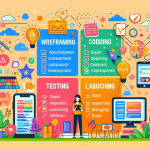In today’s competitive digital landscape, optimizing costs in app development is crucial for businesses aiming to maximize their return on investment. Here, we explore various strategies and best practices to help you achieve cost efficiency without compromising on quality.
1. Planning and Requirement Analysis
Thorough Planning: Start with a detailed project plan that outlines the scope, objectives, and deliverables. This helps in avoiding scope creep and ensures that all stakeholders are on the same page. A well-defined plan also allows for better resource allocation and time management.
Requirement Analysis: Clearly define the app’s requirements and prioritize features. This helps in focusing on essential functionalities and avoiding unnecessary additions that can inflate costs. Conducting market research and user surveys can provide valuable insights into what features are most desired by your target audience.
Risk Management: Identify potential risks early in the planning phase and develop mitigation strategies. This proactive approach can prevent costly delays and rework.
2. Choosing the Right Development Approach
Agile Methodology: Adopting agile practices allows for iterative development, which helps in identifying and addressing issues early. This reduces the risk of costly rework and ensures that the project stays on track. Agile also promotes continuous feedback and improvement, leading to a more refined final product.
MVP Development: Start with a Minimum Viable Product (MVP) to test the core functionalities. This approach helps in gathering user feedback early and making necessary adjustments before investing in full-scale development. An MVP allows you to validate your concept with minimal investment and pivot if needed.
Hybrid Development: Consider hybrid app development frameworks like React Native or Flutter. These frameworks allow you to build apps for multiple platforms (iOS and Android) using a single codebase, reducing development time and costs.
3. Leveraging Technology and Tools
Cloud Services: Utilize cloud-based services like Infrastructure as a Service (IaaS) and Platform as a Service (PaaS) to reduce upfront infrastructure costs. Cloud services offer scalability and flexibility, which can lead to significant cost savings. Providers like AWS, Azure, and Google Cloud offer various pricing models to suit different needs.
Open Source Solutions: Incorporate open-source libraries and frameworks to avoid the costs associated with proprietary software. Ensure that these solutions are well-supported and secure. Open-source tools can also accelerate development by providing pre-built components and functionalities.
DevOps Practices: Implement DevOps practices to streamline development and operations. Automation of repetitive tasks, continuous integration, and continuous deployment (CI/CD) can enhance efficiency and reduce costs.
4. Efficient Team Management
Remote Work: Embrace remote work to tap into a global talent pool. This can reduce costs associated with office space and local hiring. Remote work also offers flexibility, which can lead to higher employee satisfaction and productivity.
Cross-Functional Teams: Form cross-functional teams that include developers, designers, and testers. This promotes collaboration and reduces the time and cost associated with handoffs between different teams. Cross-functional teams can quickly adapt to changes and deliver features faster.
Outsourcing: Consider outsourcing certain aspects of development to specialized firms or freelancers. This can be cost-effective, especially for tasks that require specific expertise or are outside your core competencies.
5. Optimizing Development Processes
Automated Testing: Implement automated testing to identify bugs early in the development cycle. This reduces the cost of fixing issues later and ensures a higher quality product. Automated tests can be run frequently, providing quick feedback to developers.
Continuous Integration and Continuous Deployment (CI/CD): Use CI/CD pipelines to automate the build, test, and deployment processes. This speeds up development and reduces manual errors. CI/CD also ensures that code changes are integrated and tested regularly, leading to more stable releases.
Code Reviews: Conduct regular code reviews to maintain code quality and catch potential issues early. Peer reviews can provide different perspectives and improve the overall quality of the codebase.
6. Cost-Effective Design Practices
Reusable Components: Design reusable components that can be used across different parts of the app. This reduces development time and costs. Component-based design also promotes consistency and maintainability.
User-Centered Design: Focus on user-centered design to create intuitive and easy-to-use interfaces. This reduces the need for extensive user training and support. Conduct usability testing to gather feedback and make iterative improvements.
Design Systems: Implement a design system to standardize UI elements and interactions. This ensures consistency across the app and speeds up the design process.
7. Post-Launch Optimization
Monitoring and Analytics: Implement monitoring and analytics tools to track app performance and user behavior. This helps in identifying areas for improvement and optimizing resource usage. Tools like Google Analytics, Firebase, and New Relic can provide valuable insights.
Regular Updates: Plan for regular updates to address bugs, add new features, and improve performance. This ensures that the app remains relevant and reduces the cost of major overhauls. Regular updates also keep users engaged and satisfied.
User Feedback: Continuously gather user feedback to understand their needs and preferences. This can guide future development efforts and ensure that the app evolves in line with user expectations.
Conclusion
Cost optimization in app development is a continuous process that requires careful planning, efficient use of resources, and adoption of best practices. By implementing the strategies outlined above, businesses can achieve significant cost savings while delivering high-quality applications that meet user needs.
Feel free to reach out if you have any specific questions or need further assistance with your app development project!



